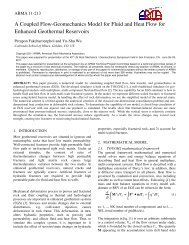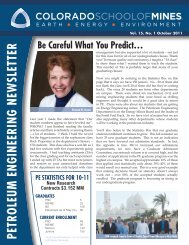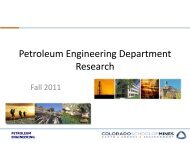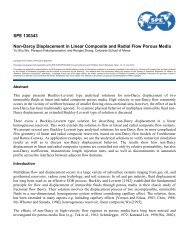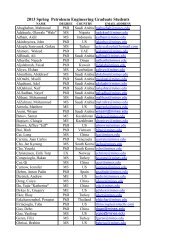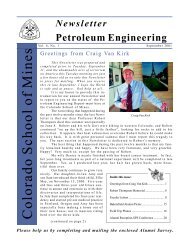SPE 146840 Pilot Testing Issues of Chemical EOR in Large ...
SPE 146840 Pilot Testing Issues of Chemical EOR in Large ...
SPE 146840 Pilot Testing Issues of Chemical EOR in Large ...
Create successful ePaper yourself
Turn your PDF publications into a flip-book with our unique Google optimized e-Paper software.
<strong>SPE</strong> <strong>146840</strong><strong>Pilot</strong> <strong>Test<strong>in</strong>g</strong> <strong>Issues</strong> <strong>of</strong> <strong>Chemical</strong> <strong>EOR</strong> <strong>in</strong> <strong>Large</strong> Fractured CarbonateReservoirsM. Kiani, H. Kazemi, E. Ozkan, Y.S Wu., <strong>SPE</strong> Colorado School <strong>of</strong> M<strong>in</strong>esCopyright 2011, Society <strong>of</strong> Petroleum Eng<strong>in</strong>eersThis paper was prepared for presentation at the <strong>SPE</strong> Annual Technical Conference and Exhibition held <strong>in</strong> Denver, Colorado, USA, 30 October–2 November 2011.This paper was selected for presentation by an <strong>SPE</strong> program committee follow<strong>in</strong>g review <strong>of</strong> <strong>in</strong>formation conta<strong>in</strong>ed <strong>in</strong> an abstract submitted by the author(s). Contents <strong>of</strong> the paper have not been reviewed by theSociety <strong>of</strong> Petroleum Eng<strong>in</strong>eers and are subject to correction by the author(s). The material does not necessarily reflect any position <strong>of</strong> the Society <strong>of</strong> Petroleum Eng<strong>in</strong>eers, its <strong>of</strong>ficers, or members. Electronicreproduction, distribution, or storage <strong>of</strong> any part <strong>of</strong> this paper without the written consent <strong>of</strong> the Society <strong>of</strong> Petroleum Eng<strong>in</strong>eers is prohibited. Permission to reproduce <strong>in</strong> pr<strong>in</strong>t is restricted to an abstract <strong>of</strong> notmore than 300 words; illustrations may not be copied. The abstract must conta<strong>in</strong> conspicuous acknowledgment <strong>of</strong> <strong>SPE</strong> copyright.AbstractMany world class large carbonate reservoirs leave beh<strong>in</strong>d at least half <strong>of</strong> the <strong>in</strong>itial oil <strong>in</strong> place. Typically water <strong>in</strong>jection isused to improve oil recovery while gas <strong>in</strong>jection is used to ma<strong>in</strong>ta<strong>in</strong> pressure or to promote oil gravity dra<strong>in</strong>age. Immisciblegas <strong>in</strong>jection, <strong>in</strong>clud<strong>in</strong>g <strong>in</strong>jection <strong>of</strong> CO 2 , has been considered but not implemented on a large scale for economic reasons.Furthermore, <strong>in</strong>terest <strong>in</strong> us<strong>in</strong>g surfactants <strong>in</strong> large carbonate reservoirs has recently flourished. As a result, we began to<strong>in</strong>vestigate the viability <strong>of</strong> design<strong>in</strong>g and conduct<strong>in</strong>g a manageable pilot test program <strong>in</strong> a large fractured carbonate reservoirus<strong>in</strong>g a s<strong>in</strong>gle-well, dual-completion system to evaluate the efficacy <strong>of</strong> the surfactant oil mobilization and oil capture.However, pilot test<strong>in</strong>g <strong>in</strong> large reservoirs is very expensive and requires a long time to complete. These issues are lessproblematic <strong>in</strong> pilot test<strong>in</strong>g <strong>of</strong> small and th<strong>in</strong> reservoirs <strong>in</strong> onshore field.In this paper we will present the results <strong>of</strong> a conceptual model to simulate the performance <strong>of</strong> surfactant flood<strong>in</strong>g <strong>in</strong> theabove-mentioned pilot test configuration. Three different model formulations, hav<strong>in</strong>g different approaches to gridd<strong>in</strong>g andgrid-ref<strong>in</strong>ement, were used. These <strong>in</strong>clude conventional dual-porosity, dual-permeability, and s<strong>in</strong>gle-porosity models withvariable porosity and permeability to simulate fracture-matrix <strong>in</strong>teractions. Simulation <strong>of</strong> pilot tests us<strong>in</strong>g dual-porositymodels shows that gravity is most effective dur<strong>in</strong>g waterflood but not as effective dur<strong>in</strong>g the surfactant <strong>in</strong>jection while <strong>in</strong> thedual-permeability models, the surfactant oil recovery is greater because both gravity and viscous displacement contribute. Wewill expla<strong>in</strong> the reasons and will <strong>in</strong>dicate which model is more reliable. In general the results <strong>of</strong> this study give an <strong>in</strong>sight <strong>in</strong>tothe viability <strong>of</strong> us<strong>in</strong>g surfactant <strong>in</strong>jection <strong>in</strong> thick carbonate reservoirs both <strong>in</strong> the pilot and production stage.IntroductionIn the U.S, typically about a third <strong>of</strong> the orig<strong>in</strong>al oil <strong>in</strong> place (OOIP) is recovered by primary and secondary recoveryprocesses, leav<strong>in</strong>g two-thirds <strong>of</strong> the oil beh<strong>in</strong>d as rema<strong>in</strong><strong>in</strong>g oil (NPC, 1984). About 60% <strong>of</strong> world‟s discovered oil reservesare <strong>in</strong> carbonate reservoirs, and many <strong>of</strong> these reservoirs are naturally fractured (Rohel and Choquette, 1985). Accord<strong>in</strong>g to arecent review <strong>of</strong> 100 fractured reservoirs (Allan and Sun, 2003), fractured carbonate reservoirs with high matrix porosity andlow matrix permeability could be good candidates for enhanced oil recovery (<strong>EOR</strong>) processes. The oil recovery from thesereservoirs is typically very low because about 80% <strong>of</strong> fractured carbonate reservoirs are either oil-wet or mixed-wet. Injectedwater will not penetrate easily <strong>in</strong>to the oil-wet porous matrix to displace oil. Wettability <strong>of</strong> carbonate reservoirs probably isthe most important oil recovery controll<strong>in</strong>g parameter (Morrow and Mason, 2001; Tong et al., 2002; Hirasaki and Zhang,2006).Typically water <strong>in</strong>jection is used to improve oil recovery, while gas <strong>in</strong>jection is used to ma<strong>in</strong>ta<strong>in</strong> pressure or to promoteoil gravity dra<strong>in</strong>age as an IOR process. If gas <strong>in</strong>jection is miscible or near-miscible, oil recovery is enhanced because afraction <strong>of</strong> the conventional residual oil is mobilized by miscibility or near-miscibility conditions. Water and gas <strong>in</strong>jectionhave been used to produce oil from the matrix <strong>in</strong> naturally fractured reservoirs (NFR) ma<strong>in</strong>ly by gravity dra<strong>in</strong>age. Viscousdisplacement <strong>in</strong> fracture-dom<strong>in</strong>ated NFR generally plays a m<strong>in</strong>or role except for chemical flood<strong>in</strong>g, where surfactants mightenter the matrix from fractures with assistance from viscous displacement to mobilize oil. Even this effect appears to be smallbecause <strong>of</strong> the lack <strong>of</strong> deep surfactant penetration.In water-wet NFR, water imbibes strongly <strong>in</strong>to the matrix and produces a lot <strong>of</strong> oil. However, <strong>in</strong> oil-wet reservoirs,water-flood<strong>in</strong>g is relatively <strong>in</strong>efficient. This is characterized by the early water breakthrough and rapidly <strong>in</strong>creas<strong>in</strong>g water-oilratio. The reason is that, for an oil-wet reservoir, the <strong>in</strong>jected water tends to travel only through the fractures and not enter the
<strong>SPE</strong> <strong>146840</strong> 3<strong>Pilot</strong> Test Design us<strong>in</strong>g Commercial S<strong>of</strong>twareWe designed a 2-D vertical conceptual model <strong>of</strong> a s<strong>in</strong>gle-well dual-completion pilot test. Three different models forsimulation <strong>of</strong> fractured reservoir were studied: a classical dual-porosity, a classical dual-permeability, and a variablepermeability/porosity f<strong>in</strong>e-grid model. The size <strong>of</strong> conceptual model <strong>in</strong> dual-porosity and dual-permeability cases is 13x1x11.Matrix porosity is 0.05 and total fracture porosity is 0.02. Matrix block sizes are 20 ft <strong>in</strong> all sides. Permeability <strong>of</strong> matrix is10 md and fracture is 10000 md. In variable permeability/porosity f<strong>in</strong>e-grid model the size <strong>of</strong> fracture is 0.1 ft and fractureporosity is 0.98 percent. Figure 1, shows the schematic view <strong>of</strong> the variable permeability/porosity f<strong>in</strong>e-grid model for a twowellsystem <strong>of</strong> <strong>in</strong>jection and production. To reach the same oil recovery dur<strong>in</strong>g water flood a much f<strong>in</strong>ed-grid model isnecessary. Do<strong>in</strong>g this, from orig<strong>in</strong>al model size with 143 grids, we ended up with more than 10530 grids. This conceptualmodel has been built us<strong>in</strong>g CMG 1 . Simulation run time for this model is more than 10 hours on a PC with 2.16 GHz CPU and4 GHz RAM. Runn<strong>in</strong>g dual-porosity and dual-permeability takes less than 5 m<strong>in</strong>utes on the same PC. Rock fluid data dur<strong>in</strong>gwaterflood and surfactant flood has been shown <strong>in</strong> Figure 3. Two sets <strong>of</strong> relative permeability for water flood<strong>in</strong>g andsurfactant <strong>in</strong>jection are provided. Capillary pressure curve at high concentration <strong>in</strong>creases to values close to zero or <strong>in</strong>wettability alteration conditions turns to positive.Recovery factor for 600 days <strong>of</strong> water flood<strong>in</strong>g followed by 80 days <strong>of</strong> surfactant <strong>in</strong>jection has been shown <strong>in</strong> Figure 2.From Figure 2 it is seen that dur<strong>in</strong>g surfactant <strong>in</strong>jection dual-porosity and dual-permeability models cannot produce the sameas variable-permeability/porosity f<strong>in</strong>e-grid model. Surfactant <strong>in</strong>cremental oil recovery <strong>in</strong> dual-porosity and dual-permeabilityis at most 1 percent but <strong>in</strong> the other model is more than 3 percent. The probable reason for this difference is that gravity andviscous forces <strong>in</strong> dual-porosity model is not effective as variable porosity/permeability model.Enough concentration <strong>of</strong> surfactant <strong>in</strong> matrix will reduce the <strong>in</strong>terfacial tension between water and oil phases to suchlower values that facilitates the phase mobilization. Figure 3 shows the IFT reduction around the <strong>in</strong>jection well <strong>in</strong> less thanone month <strong>of</strong> surfactant <strong>in</strong>jection <strong>in</strong> variable permeability/porosity f<strong>in</strong>e-grid model. As it is seen <strong>in</strong> Figure 3, the IFT can bereduced to values close to zero. Production and <strong>in</strong>jection distance has been chosen short, 40 ft, to not let surfactant go farfrom the pilot area. Production and <strong>in</strong>jection <strong>in</strong>tervals are completed <strong>in</strong> fracture nodes.Figure 1. Variable permeability/porosity f<strong>in</strong>e-grid model for a 5x5 matrix ref<strong>in</strong>ement1 Computer Model<strong>in</strong>g Group
4 <strong>SPE</strong> <strong>146840</strong>Figure 2. Incremental surfactant oil recoveryfrom s<strong>in</strong>gle-well dual-completionFigure 3. IFT reduction around the s<strong>in</strong>gle-well dualcompletiondesign<strong>Pilot</strong> Test Design us<strong>in</strong>g In-house Developed Numerical SimulatorGenerally, dual-porosity model is based on the discrete fracture network (DFN) models. In this model fractures are connectedbut matrices are not. Fracture and matrix can be connected by means <strong>of</strong> transfer function. S<strong>in</strong>ce <strong>in</strong> this model there is nomatrix connection capillary discont<strong>in</strong>uity exists. Because <strong>of</strong> overburden pressures most <strong>of</strong> the horizontal fractures are closedand therefore vertical fractures dom<strong>in</strong>ate the fluid flow <strong>in</strong>side the fractured reservoirs. In these cases one can use dualpermeabilitymodels too. In dual-permeability models matrices are connected and because <strong>of</strong> this connectivity there iscapillary cont<strong>in</strong>uity. This model will result <strong>in</strong> more oil recovery compar<strong>in</strong>g to the dual-porosity model.Case 1: Dual-porosity modelFor a two phase system <strong>in</strong>clud<strong>in</strong>g water and oil follow<strong>in</strong>g f<strong>in</strong>ite-difference forms <strong>of</strong> flow equations is provided:Fracture water material balance,^ P<strong>of</strong>Swf. k f , eff. wf P<strong>of</strong> wD P cw<strong>of</strong> w qwf f Swf c cw ttMatrix water material balance,Pom SwmwmSwm c mcw mttFracture oil material balance,^ P<strong>of</strong>S<strong>of</strong>. k f , eff. <strong>of</strong> P<strong>of</strong> oD o q<strong>of</strong> f S<strong>of</strong> c co ttMatrix oil material balance,Pom SomomSom c mco (4)mttIn dual-porosity formulation transfer function is the rate <strong>of</strong> fluid exchange between fracture and matrix <strong>in</strong> a grid block.Transfer functions for water and oil system are given by z w 0.006328 kmwf / m Po Po w h wf hwm P mcw<strong>of</strong>Pcwom(5) f z m wf fo 0.006328 kmom / fPo Po o h h (6)wmThis formulations account for pressure gradient (viscous force), gravity, and capillarity <strong>in</strong> each local matrix and fracturesystem. A form <strong>of</strong> transfer function which accounts for fluid expansion and molecular diffusion is provided by Ramirez et al.,2009. In contrast with s<strong>in</strong>gle-porosity formulations, fluid exchange <strong>in</strong> a dual-porosity system is based on replacement processrather than displacement. To account for a better fluid displacement <strong>in</strong> dual-porosity models viscous force <strong>in</strong> aboveformulations needs to be adjusted. We have applied this adjustment and we will present the results at the end <strong>of</strong> this paper.Depend<strong>in</strong>g on the flow<strong>in</strong>g phase present, capillary and gravity forces are generally dom<strong>in</strong>ant <strong>in</strong> fractured reservoirs, thereforean approximation form <strong>of</strong> Eq. 5 and Eq. 6 is:wf / m<strong>of</strong> / m z w 0.006328 km P cw<strong>of</strong>Pcwom w oh hwm t wf (1)(2)(3)(7)
<strong>SPE</strong> <strong>146840</strong> 5Eq. 7 is called pseudo transfer function. Us<strong>in</strong>g this form we will have:o (8)wIn Eqs. 5, 6, and 7 the terms <strong>in</strong>side the bracket represent the driv<strong>in</strong>g forces. We have used both forms <strong>of</strong> transfer function <strong>in</strong>dual-porosity formulation. They provide very close results because as po<strong>in</strong>ted before <strong>in</strong> current dual-porosity formulationpressure gradient is negligible. The effects <strong>of</strong> capillary and gravity forces are different from case to case. They can worktogether or can be aga<strong>in</strong>st each other. For example <strong>in</strong> gas <strong>in</strong>jection always gravity difference will play the major role but <strong>in</strong>water flood<strong>in</strong>g both mechanisms might be effective. Add<strong>in</strong>g water and oil material balance equations give global pressureequation, and from that equation implicitly we can obta<strong>in</strong> fracture and matrix pressures. Overall pressure equation is providedby Eq.9:^ P<strong>of</strong>.k f , eff tf P<strong>of</strong> wwf o<strong>of</strong> D wf P cw<strong>of</strong> t qtf fctft(9)Solv<strong>in</strong>g water or oil material balance gives saturation explicitly per time step. To obta<strong>in</strong> saturations <strong>in</strong> matrix either Eq.2 orEq.4 is used. Auxillary equations for this part are given <strong>in</strong> Appendix A.Fracture surfactant material balanceSurfactant concentration per time step can be solved explicitly or implicitly us<strong>in</strong>g Eq. 9. In this equation pressures andsaturations are known at n+1 level. This equation <strong>in</strong>cludes diffusivity term, surfactant participation <strong>in</strong> oil phase, andsurfactant adsorption on the solid phase surface.kf , effwf kf , eff<strong>of</strong>. Cwsf Pwf wD Cwsf P<strong>of</strong> oD wCwsf / moCosf / m BwfB<strong>of</strong> D D ^^ SwfS (10)<strong>of</strong>. S .~ w C wsm S ~ o C osm Cwsf qwf Cosf q<strong>of</strong> f Cwsf Cosf t BwfB 1 f . r.asf <strong>of</strong>m m Eq. 11 accounts for surfactant participitation <strong>in</strong>to oil phase. To account for adsorption we used Longmuir isotherm adsorptionformula. This formulation is provided <strong>in</strong> Appendix B.Cos sCws (11)fMatrix surfactant material balanceSurfactant can penetrate <strong>in</strong>to matrix through transfer function terms; Eq. 12 accounts for this process. Upstream weight<strong>in</strong>gdeterm<strong>in</strong>e whether surfactant goes <strong>in</strong>to or out <strong>of</strong> matrix. In ideal condition surfactant from fracture goes with water transferfunction term. Adsorption is <strong>in</strong>cluded <strong>in</strong> the second part <strong>of</strong> the left right hand side <strong>of</strong> Eq.12. SwmS omwCwsf / m oCosf / m m Cwsm Cosm 1 m . r.asmt BwmBom (12)A conceptual model with the size <strong>of</strong> 10x1x10 grid blocks, with almost the same size <strong>of</strong> the conceptual model <strong>in</strong> CMG, hasbeen built us<strong>in</strong>g three different methods; dual-porosity, dual-permeability, and variable permeability/porosity f<strong>in</strong>e-gridmodel. Implicit-pressure/explicit-saturation (IMPES) formulation is implemented. S<strong>in</strong>gle-well dual-completion method isused <strong>in</strong> this conceptual model with <strong>in</strong>jection rate <strong>of</strong> 30 bbls/day. Surfactant <strong>in</strong>cremental oil recovery was <strong>in</strong>vestigated byus<strong>in</strong>g IFT reduction and wettability alteration methods. Dur<strong>in</strong>g surfactant <strong>in</strong>jection simulator calculates IFT, Capillarynumber or Bond number, residual oil saturation, relative permeability, capillary pressure, fluid heights <strong>in</strong> fracture and matrixnodes. IFT will be calculated based on surfactant concentration. We used two forms <strong>of</strong> Bond number and Capillary number:mkm w oNB . IFT.cosWhere,mw ogravity gradient <strong>in</strong> [psi/ft], m, porosity <strong>of</strong> the matrix,IFT, water-oil <strong>in</strong>terfacial tension <strong>in</strong> [dynes/cm], and cos is contact angle. In addition to use the above formulation, we haveused a comb<strong>in</strong>ation form <strong>of</strong> Capillary number and Bond number <strong>in</strong> the matrix, which gives close results as Bond number.Us<strong>in</strong>g the driv<strong>in</strong>g force <strong>in</strong> pseudo transfer function, we have:Nck is the absolute permeability <strong>of</strong> the matrix [md], 2.262 108 wf wmkmP cw<strong>of</strong>Pcwom w o h hm z. IFT . cos Where, z is matrix block height (ft) <strong>in</strong> z direction. To achieve a Bond number or Capillary number greater than 10-5 , weneed to have a very low IFT, which requires large amount <strong>of</strong> surfactant concentration <strong>in</strong>side the matrix. Our simulationshows that we need to <strong>in</strong>ject a high concentration <strong>in</strong>to the reservoir. Residual oil saturation will be <strong>in</strong>terpolated based on(13)(14)
6 <strong>SPE</strong> <strong>146840</strong>Capillary or Bond number. For IFT <strong>in</strong>terpolation versus concentration we used work done by Gupta and Mohanty, 2008, andfor residual oil saturation versus Capillary number we used work presented by Kamath et al., 2001. Surfactant concentrationis calculated <strong>in</strong> matrix and fracture <strong>in</strong> both implicit and explicit formulations.Figure 4 shows the recovery factor and <strong>in</strong>cremental oil recovery for 1000 days <strong>of</strong> water flood followed by 300 days <strong>of</strong>surfactant flood. Surfactant <strong>in</strong>jection <strong>in</strong> a water <strong>in</strong>vaded zone us<strong>in</strong>g dual-porosity model results <strong>in</strong> a very low <strong>in</strong>cremental oilrecovery, here is less than one percent. Because <strong>of</strong> oil-wet nature <strong>of</strong> carbonate reservoir negative capillary pressure isovercom<strong>in</strong>g the other two mechanisms; gravity and viscous displacement forces. Gravity force is negligible at the end <strong>of</strong>waterflood because fractures around matrix blocks are mostly full <strong>of</strong> water. Pressure difference between matrix and adjacentfractures are very small, so viscous forces also are not effective. Therefore fluid exchange will not take place <strong>in</strong> an effectiveway to carry enough surfactant <strong>in</strong>to the matrix block. Eq. 15 was used to calculate the capillary pressure <strong>in</strong> presence <strong>of</strong>surfactant. At high concentrations IFT can reduce capillary pressure to zero.IFT surfPcsurf Pc S(15)or sfIFT<strong>in</strong>itialWhere, Pc (surf) is the capillary pressure <strong>in</strong> presence <strong>of</strong> surfactant, and Sor sf is the new residual oil saturation calculated atthat grid. In wettability-<strong>in</strong>duced <strong>in</strong>cremental oil recovery, it is believed that at high concentrations surfactant can change thecapillary pressure values <strong>in</strong>to positive values. This results <strong>in</strong> complete or partially alter<strong>in</strong>g the wettability <strong>of</strong> the rock. In thispaper we used assumptions based on the surfactant concentration to change the capillary pressure (Eq. 16).Maximum shift( 0.5 psi)Pc ( surf ) Pc Sor C(16)sfsgridCs<strong>in</strong>jectionWhere Cs <strong>in</strong>jection is the concentration <strong>in</strong> <strong>in</strong>jection well, Cs grid is the concentration <strong>in</strong> each grid. Based on the concentration <strong>in</strong>each grid a vlue between 0 to 0.5 psi will be added to the capillary pressure at that node. This method is just anapproximation. Another work to model the wettability alteration by chang<strong>in</strong>g the capillary pressure based on concentrationwas done by Farhad<strong>in</strong>ia and Delshad, 2010. The maximum negative capillary at the end <strong>of</strong> water flood <strong>in</strong> our system isaround -0.15 psi. For example for concentration <strong>of</strong> 4000 ppm, capillary at wettability alteration condition will be +0.05 psi <strong>in</strong>that grid.Figure 4. Recovery factor dur<strong>in</strong>g water-flood and <strong>in</strong>cremental oil recovery for IFT <strong>in</strong>duced andwettability altered surfactant <strong>in</strong>jection <strong>in</strong> dual-porosityCase 2: Dual-porosity matrix ref<strong>in</strong>ement formulationDual-porosity model does not produce <strong>in</strong>cremental oil recovery dur<strong>in</strong>g surfactant <strong>in</strong>jection. After water flood<strong>in</strong>g all fracturesare nearly full <strong>of</strong> water, therefore gravity force will not be effective to help surfactant penetrate <strong>in</strong>to the matrix. On the otherhand viscous force (pressure gradient) is negligible. Therefore, the only mechanism rema<strong>in</strong>s is capillary pressure but oil-wetnature <strong>of</strong> the fractured reservoir makes it hard for surfactant to penetrate <strong>in</strong>to matrix block. We believe that <strong>in</strong> a real situationsurfactant might only can touches the surface or a very shallow deep <strong>of</strong> the matrix. To be more realistic we chose matrixref<strong>in</strong>ement approach to <strong>in</strong>vestigate the effect <strong>of</strong> ref<strong>in</strong>ement on both water flood<strong>in</strong>g and surfactant <strong>in</strong>jection. In this method wekept the same matrix block size (20ft <strong>in</strong> all directions) and ref<strong>in</strong>ed it <strong>in</strong>to sub-<strong>in</strong>ternal-blocks. A schematic view <strong>of</strong> one nestedmatrix block is shown <strong>in</strong> Figure 5. In this figure orig<strong>in</strong>al matrix block is divided <strong>in</strong>to three nested blocks.
<strong>SPE</strong> <strong>146840</strong> 7Figure 5. Matrix ref<strong>in</strong>ement us<strong>in</strong>g three nested blocks (Bulogun, 2005)For simplicity we assumed that all three blocks have the same volume. The volume <strong>of</strong> each block is one third <strong>of</strong> the outermatrix block (orig<strong>in</strong>al block).Lx 1Ly1LzV V V (17)m1 m2 m33In this case total pressure equation will be solved for the <strong>in</strong>teraction between fracture and first matrix r<strong>in</strong>g and all <strong>of</strong> the rest<strong>of</strong> nested blocks are connected through their transfer function. So Eq. 9 will have the new form:V^ Pm1<strong>of</strong>.k f , eff tf P<strong>of</strong> wwf o<strong>of</strong> D wf P cw<strong>of</strong> t qt fctfVblock t(18)Where, V m1 is the volume <strong>of</strong> the first r<strong>in</strong>g and V block is the volume <strong>of</strong> the whole matrix block. Each nested matrix block has itsown shape factor, pressure, phase saturation, capillary pressure, fluid heights, and compressibilities. Therefore we need tocalculate the separate transfer functions. In fact these nested blocks are connected through transfer function terms. Follow<strong>in</strong>gare the developed shape factor and transfer functions for each nested matrix block.Shape factor for a ref<strong>in</strong>ed matrixIn below formulations “f” stands for fracture and “1”, “2”, and “3” stand for first, second, and third nested matrix blocksrespectively.24 L L x1y1f /1 Lx 1Ly1 L y1 Ly2 Lx 1Lx2 (19)1/21/224 L L x2y2 Lx 1Ly1 L y1 Ly3 Lx 1Lx3 (20)24 L L x2y2 Lx 1Ly1 L y1 Ly3 Lx 1Lx3 (21)Vertical transfer function for each r<strong>in</strong>g is as follow<strong>in</strong>g:zf /112 Lx1Ly1 Lx 2Ly2 Lx 1Ly1Lz Lz (22)12 Lx 2Ly2 Lx3Ly3z1/2 Lx 1Ly1Lz Lz (23)12 Lx3Ly3z2/3 Lx 1Ly1Lz Lz (24)Above equations have been derived from the general form <strong>of</strong> shape factor <strong>in</strong>troduced by Kazemi et al., 1992:1 J Aj (25)V Dj1jWhere V is the volume <strong>of</strong> the matrix block, A is the open face normal to the flow, and D is the half length from the center <strong>of</strong>the matrix block. Assum<strong>in</strong>g L x1 = L y1 = L z =20 ft calculation <strong>of</strong> the lengths and shape factor for each <strong>of</strong> the r<strong>in</strong>gs gives:f /1 0.6, 1/2 0.24, 2/3 0.08L x2 =L y2 = 16.33 ft, L x3 =L y3 =11.33ft, and ft -2
8 <strong>SPE</strong> <strong>146840</strong>Transfer functionsFor fracture and first r<strong>in</strong>g:n n1 n1n n n nw f /1 f /1km / 1.wf m P<strong>of</strong> Pom w hwf hwm 1 Pcw<strong>of</strong> Pcwom1 (26)For matrix r<strong>in</strong>g 1 and matrix r<strong>in</strong>g 2:n n1 n1n n n nw1/2 1/2km 1/ 2.wm m Pom 1 Pom 2 w hwm1 hwm 2 Pcwom 1 Pcwom2 (27)For matrix r<strong>in</strong>g 2 and matrix r<strong>in</strong>g 3:n n1 n1n n n nw2/3 2/3km 2/ 3.wm m Pom 2 Pom 3 w hwm 2 hwm 3 Pcwom 2 Pcwom3 (28)Upstream weight<strong>in</strong>g are used <strong>in</strong> the above equations. Also an <strong>in</strong>ternal matrix <strong>of</strong> coefficients has been solved to obta<strong>in</strong> matrixpressure at n+1 level <strong>in</strong> each nested matrix block. Therefore transfer function is calculated <strong>in</strong> a semi-implicit method. Solv<strong>in</strong>gnew matrix <strong>of</strong> coefficients does not affect the simulation run time. Dual-porosity without ref<strong>in</strong>ement takes 123 seconds to runwhile dual-porosity with ref<strong>in</strong>ement takes 133 seconds.As it is seen <strong>in</strong> Figure 6, compar<strong>in</strong>g to the dual-porosity without matrix ref<strong>in</strong>ement surfactant does better us<strong>in</strong>g IFTreduction and wettability alteration assumptions; two percent and 4 percent respectively. Still <strong>in</strong> this formulation viscousforce is not effective. In the next part <strong>of</strong> this paper we have built a dual-permeability model for purpose <strong>of</strong> check<strong>in</strong>g theref<strong>in</strong>ement approach and compare the results.Case 3: Dual-permeability F<strong>in</strong>e-grid FormulationIt is not exactly dual-permeability formulation but the approach is the same. The size <strong>of</strong> the model is 10x1x10 grid blocks.Each matrix has been ref<strong>in</strong>ed <strong>in</strong>to 5 sub grids <strong>in</strong> „x‟ direction to create the same ref<strong>in</strong>ement as dual-porosity model withmatrix ref<strong>in</strong>ement. All matrix blocks are connected vertically and disconnected by a fracture <strong>in</strong> „x‟ direction. There are twohorizontal fractures at the top and bottom <strong>of</strong> the bed to connect vertical fractures. After ref<strong>in</strong>ement the size <strong>of</strong> the model is55x1x15. Simulation <strong>of</strong> this model takes almost more than 2 hrs. All properties for matrix and fracture are the same as dualporositymodel. Result <strong>of</strong> simulation is shown <strong>in</strong> Figure 7.Figure 6. Dual-porosity nested matrix block,water flood recovery and <strong>in</strong>crementalsurfactant oil recoveryFigure 7. Wtareflood recovery factor and <strong>in</strong>crementalsurfactant oil recovery us<strong>in</strong>g IFT-<strong>in</strong>duced and wettabilityalteration <strong>in</strong> Dual-permeability (DK) approachWater-flood<strong>in</strong>g results <strong>in</strong> 36 percent recovery and surfactant <strong>in</strong>jection <strong>in</strong> water <strong>in</strong>vaded zone results <strong>in</strong> 6 percent <strong>in</strong>crementaloil recovery by IFT reduction and more than 8 percent by wettability alteration assumptions. Figure 8 shows comparisonbetween dual-permeability and dual-porosity re<strong>in</strong>ed matrix. In dual-permeability formulation dur<strong>in</strong>g water flood andsurfactant <strong>in</strong>jection viscous and gravity forces overcome the negative capillary pressure. In the other words these two forcesare still effective dur<strong>in</strong>g surfactant <strong>in</strong>jection. Because gravity always will be calculated from the top <strong>of</strong> the reservoir bed nomatter <strong>of</strong> what k<strong>in</strong>d <strong>of</strong> porosity or permeability exist <strong>in</strong> the system. We have shown this effect by compar<strong>in</strong>g the above modelwith another dual-permeability model that has th<strong>in</strong> impermeable layers <strong>in</strong> z direction (Figure 9). The vertical thicknesses <strong>of</strong>these layers are 0.4 ft. Both models produce almost the same, which means exist<strong>in</strong>g <strong>of</strong> some zero permeability layers wouldnot affect the oil production from dual-permeability model.
<strong>SPE</strong> <strong>146840</strong> 11<strong>Pilot</strong> <strong>Test<strong>in</strong>g</strong>Injection-production multiple-well pattern pilot is very time-consum<strong>in</strong>g and expensive <strong>in</strong> large <strong>of</strong>fshore reservoirs. S<strong>in</strong>glewellmultiple might-completion design be a good way to reduce the time and cost. This <strong>in</strong>cludes dual- and triple-completionsmethods. In dual-completion mobilized oil captur<strong>in</strong>g is more difficult. In triple-completion, the mobilized oil captur<strong>in</strong>g ismore focused.ConclusionsThe numerical model<strong>in</strong>g <strong>of</strong> pilot test<strong>in</strong>g for surfactant <strong>in</strong>jection <strong>in</strong> large carbonate reservoirs led to the follow<strong>in</strong>g conclusions:1 Surfactant can mobilize rema<strong>in</strong><strong>in</strong>g oil <strong>in</strong> water-<strong>in</strong>vaded naturally fractured carbonate reservoirs to enhance oilrecovery, but the selection <strong>of</strong> the <strong>EOR</strong> chemical and the method <strong>of</strong> its delivery will determ<strong>in</strong>e the economic viability.2 For large carbonate reservoirs, especially <strong>in</strong> an <strong>of</strong>fshore environment, well-to-well pilot test<strong>in</strong>g is prohibitivebecause <strong>of</strong> oil capture and base l<strong>in</strong>e issues. However, pilot test<strong>in</strong>g <strong>in</strong> a dual- and/or triple-completion s<strong>in</strong>gle-well isplausible.3 The ma<strong>in</strong> issue with surfactant <strong>in</strong>jection <strong>in</strong> carbonate NFR is the low penetration <strong>of</strong> surfactant <strong>in</strong>to the matrix.4 Assum<strong>in</strong>g enough surfactant concentration penetrates matrix, IFT reduction and capillary pressure change to waterwetconditions become the ma<strong>in</strong> factors for mobiliz<strong>in</strong>g oil.5 In oil-wet rocks, spontaneous capillary imbibition is absent. And, <strong>in</strong> fact, negative capillary pressures are present,which are h<strong>in</strong>drance to oil dra<strong>in</strong>age; however, gravity can overcome capillary forces to promote dra<strong>in</strong>age6 With high pressure gradients between fracture and matrix viscous displacement could also promote oil dra<strong>in</strong>age7 <strong>Chemical</strong> <strong>in</strong>jection <strong>in</strong> dual-porosity formulation <strong>of</strong> fractured carbonate reservoirs results <strong>in</strong> lower <strong>in</strong>cremental oilrecovery compared to a dual-permeability formulation. Because gravity and viscous displacement force <strong>in</strong> dualpermeabilitycase are dom<strong>in</strong>at<strong>in</strong>g the negative capillary pressure, which this is <strong>in</strong> contrast with dual-porosity case.8 Ref<strong>in</strong>ed matrix dual-porosity improves <strong>in</strong>cremental oil recovery from surfactant.9 Surfactant <strong>in</strong>jection <strong>in</strong> a dual-porosity formulation will become more effective when viscous force term is <strong>in</strong>cluded.10 Exist<strong>in</strong>g <strong>of</strong> low permeability th<strong>in</strong> layers <strong>in</strong> dual-permeability formulation does not affect the <strong>in</strong>cremental oilrecovery from a specific target perforation. This is because gravity is a major mechanism that still is effective <strong>in</strong>such a case.11 Us<strong>in</strong>g low-adsorption surfactants are necessary for oil mobilization12 Small fracture spac<strong>in</strong>g results <strong>in</strong> more oil recovery <strong>in</strong> the dual-permeability models.13 Tall matrix blocks (tall fracture heights) result <strong>in</strong> more oil recovery <strong>in</strong> dual-porosity models.14 Dur<strong>in</strong>g the pilot test, boundary conditions must be ma<strong>in</strong>ta<strong>in</strong>ed as <strong>in</strong> the pre-test operat<strong>in</strong>g conditions.15 Field application <strong>of</strong> surfactant <strong>EOR</strong> technology is very complex and requires expertise and experience.AcknowledgementThe authors thank PEMEX for its f<strong>in</strong>ancial support and Marathon Center <strong>of</strong> Excellence for Reservoir Studies at ColoradoSchool <strong>of</strong> M<strong>in</strong>es for its technical support <strong>of</strong> this study.Nomenclaturepressure <strong>of</strong> phase , psiwater-oil capillary pressure, psimatrix / fracture transfer function for phase , 1/dayeffective fracture permeability,total system compressibility, Lt2/m, psi-1compressibility <strong>of</strong> phase , Lt2/m, psi-1pore compressibility, Lt2/m, psi-1Surfactant concentration <strong>in</strong> phase , ppmgravity head for phase , ftfracture height, L, ftheight <strong>of</strong> water <strong>in</strong>side the fracture, ftheight <strong>of</strong> water <strong>in</strong>side the matrix, ft0.006328* absolute permeability, L2, md0.006328* fracture absolute permeability, L2, mdLangmuir coefficient
12 <strong>SPE</strong> <strong>146840</strong>DLrelative permeability to phase , dimensionlesssource/s<strong>in</strong>k term for phase , L3/t, ft3/ds<strong>in</strong>k/source term per volume <strong>of</strong> grid block, 1/t, 1/daysaturation <strong>of</strong> phase , fractionresidual saturation <strong>of</strong> phase , fractionformation volume factor <strong>of</strong> phase , rb/STBDepth, ftmatrix block dimension, ft0.006328 conversion factor to the field units <strong>of</strong> psi, psi/ft, cp, ft, md,…Greek LettersOperatorsSuperscriptSubscriptmowReferencesmobility <strong>of</strong> phase , dimensionlesstotal system mobility, dimensionlessmatrix porosity, fractionfracture porosity, fractionfluid gravity gradient for phase , psi/ftmatrix block shape factor, L-2, 1/ ft2matrix shape factor <strong>in</strong> z direction, L-2, 1/ ft22partition coefficientrock density,gradient operatordivergence operatorcurrent time levelnext time level to be solvedmatrixfractureoilwatertotal, systemfluid phase (for gas, and water, respectively)Alvarado V., and Manrique E.J., 2010, Enhanced Oil Recovery: an Update Review, www.mdpi.com/journal/energiesBalogun, A., 2005, An Improved Water-Oil Transfer-Function for Dual-porosity Dual-permeability Systems, Master Thesis, ColoradoSchool <strong>of</strong> M<strong>in</strong>es, Golden, CO, 90p.Chen, H.L., Lucas, L.R., Nogaret, L.A.D., Yang, H.D., Kenyon, D.E., 2000, Laboratory Monitor<strong>in</strong>g <strong>of</strong> Surfactant Imbibition Us<strong>in</strong>gComputerized Tomography, <strong>SPE</strong> 59006, <strong>SPE</strong> International Petroleum Conference and Exhibition <strong>in</strong> Mexico, VillahermosaChen, H. L., Lucas, L. R., Nogaret, L. A. D., Yang, H. D., Kenyon, D. E., 2001, Laboratory Monitor<strong>in</strong>g <strong>of</strong> Surfactant Imbibition Us<strong>in</strong>gComputerized Tomography, <strong>SPE</strong>-69197, <strong>SPE</strong>REFarhad<strong>in</strong>ia, M.A. and Delshad, M., 2010, Model<strong>in</strong>g and Assessment <strong>of</strong> Wettability Alteration Processes <strong>in</strong> Fractured Carbonate us<strong>in</strong>g DualPorosity and Discrete Fracture Approaches, <strong>SPE</strong> Improved Oil Recovery Symposium, Tulsa, OKGupta, R., Mohanty, K. K., 2008, Wettability Alteration <strong>of</strong> Fractured Reservoirs, <strong>SPE</strong>/DOE Improved Oil Recovery Symposium, Tulsa,OKHirasaki, G. and Zhang, D. L., 2004, Surface Chemistry <strong>of</strong> Oil Recovery from Fractural, Oil-Wet, Carbonate Formations, <strong>SPE</strong> Journal,p.151-162Hirasaki, G. J., Miller, C. A., Pope, G. A., and Jackson, R. E., 2004, Surfactant Based Enhanced Oil recovery and Foam Mobility Control,1st Annual Technical Report, DOE, DE-FC26-03NT15406, Rice University, Houston, TX
<strong>SPE</strong> <strong>146840</strong> 13Kamath, J., Meyer, R.F., Nakagawa, F.M., 2001, Understand<strong>in</strong>g Waterflood Residual Oil Saturation <strong>of</strong> Four Carbonate Rock Type, <strong>SPE</strong>Annual Technical Conference and Exhibition, New Orleans, LAKazemi, H., Gilman, J.R., Elsharkawy, A.M., 1992, Analytical and Numerical Solution <strong>of</strong> Oil Recovery from Fractured Reservoirs withEmpirical Transfer Functions, <strong>SPE</strong> Reservoir Eng<strong>in</strong>eer<strong>in</strong>g, SanAntonio, TXKazemi, H., Merill, L. S. Jr., Porterfield, K. L. and Zaman, P. R., 1976, Numerical Simulation <strong>of</strong> Water-Oil Flow <strong>in</strong> Naturally FracturedReservoirs, <strong>SPE</strong> JournalMann<strong>in</strong>g, R.K., Pope, G.A., Lake, L.W., Paul, G.W., Wesson, T.C., 1983, A Technical Survey <strong>of</strong> Polymer Flood<strong>in</strong>g Projects, Report No.DOE/BC/10327-19, U.S. Department <strong>of</strong> Energy: Tulsa, OK, USA, p. 329Manrique, E.J., Muci, V.E., Gurf<strong>in</strong>kel, M. E., 2007, <strong>EOR</strong> Field Experiences <strong>in</strong> Carbonate Reservoirs <strong>in</strong> the United States, <strong>SPE</strong> ReservoirEvaluation Eng. P. 667Manrique, E.; de Carvajal, G.; Anselmi, L.; Romero, C.; Chacon, L., 2000, Alkali/Surfactant/Polymer at VLA 6/9/21 Field <strong>in</strong> MaracaiboLake: Experimental Results and <strong>Pilot</strong> Project Design, <strong>SPE</strong> 59363, In Proceed<strong>in</strong>gs <strong>of</strong> <strong>SPE</strong>/DOE Improved Oil Recovery Symposium,Tulsa, OK.Moritis, G., 2004, <strong>EOR</strong> Cont<strong>in</strong>ues to Unlock Oil Resources, Report on Enhanced Oil Recovery, Oil & Gas JournalMorrow, N.R. and Mason, G., 2001, Recovery <strong>of</strong> Oil by Spontaneous Imbibition, Current Op<strong>in</strong>ion <strong>in</strong> Colloid and Interface Science, p.321Othman, M.; Chong, M.O.; Sai, R.M.; Za<strong>in</strong>al, S.; Zakaria, M.S.; Yaacob, A.A., 2007, Meet<strong>in</strong>g the Challenges <strong>in</strong> Alkal<strong>in</strong>e Surfactant <strong>Pilot</strong>Project Implementation at Angsi Field, Offshore Malaysia, <strong>SPE</strong> 109033, Offshore Europe, Aberdeen, Scotland, U.K.Ramirez, B., Kazemi, H., Alkobaisi, M., and Ozkan, E., 2008, A Critical Review for Proper Use <strong>of</strong> Water/Oil/Gas Transfer Functions <strong>in</strong>Dual-Porosity Naturally Fractured Reservoirs: Part I, <strong>SPE</strong> Reservoir Evaluation and Eng<strong>in</strong>eer<strong>in</strong>g, CA.Seethepalli, B. A., B., Mohanty K. K., 2004, Wettability Alteration dur<strong>in</strong>g Surfactant Flood<strong>in</strong>g <strong>of</strong> Carbonate Reservoirs, <strong>SPE</strong> 89423, <strong>SPE</strong>/DOE 14th Symposium on IOR, Tulsa OKTong, Z. X.; Morrow, N. R. and Xie, X., 2002, Spontaneous Imbibition For Mixed-Wettability States In Sandstones Induced ByAdsorption From Crude Oil, 7th International Symposium on Reservoir Wettability, Tasmania, AustraliaXie, X., Weiss, W. W., Tong, Z., Morrow, N. R., 2004, Improved Oil Recovery from Carbonate Reservoirs by <strong>Chemical</strong> Stimulation, <strong>SPE</strong>89424, <strong>SPE</strong>/DOE 14th Symposium on IOR. Tulsa OKYang, H. D., and Wadleigh, E. E., 2000, Dilute Surfactant IOR-Design Improvement for Massive, Fractured Carbonate Applications, <strong>SPE</strong>59009, <strong>SPE</strong> International Petroleum Conference and Exhibition <strong>in</strong> Mexico, VillahermosaAppendix A – Auxillary equations used <strong>in</strong> <strong>in</strong>-house simualtorShape factor for dual-porosity formulation w/o ref<strong>in</strong>ement:Shape factor <strong>in</strong> z direction for dual-porosity w/o ref<strong>in</strong>ement:Fluid Gravity:1 1 1 4( )L L L z42L z1442 2 2x y zTotal compressibility: ct c Swcw Soco Sgcgc wfBwfpWater compressibility: 1 B wfFormation volume factor: B B 1c P wf wfb wb wOil compressibility: 1 B<strong>of</strong>c<strong>of</strong>B PMobility Ratio:krTotal Mobility Ratio: t wg oPhase Fractional Flow:fRelative Permeability: k k S<strong>of</strong>rrwCapillary Pressure: Pcow Pcow ( Sw)Saturation Constra<strong>in</strong>ts: S S S 1w o gWater level <strong>in</strong> matrix or fracture Swm/ f S/hwm / f 1Swrm fStwrm f/ orwm/fLz
14 <strong>SPE</strong> <strong>146840</strong>Oil level <strong>in</strong> matrix or fracture1Swm/ fS/hom / f 1Swrm/ fS/APPENDIX B – relative permeability and capillary pressure equations for <strong>in</strong>-house simulator and <strong>in</strong>putsfor commercial s<strong>of</strong>twareWater relative permeability <strong>in</strong> matrix/fracture: S*wm/ f S wrm/fkrwm/ f krwm/f1 Swrm/ fS orwm/f Oil relative permeability <strong>in</strong> matrix/fracture:1S*wm/ fSorwm/fkrom/ f krom/f1 Swrm/ fS orwm/f Capillary pressure <strong>in</strong> matrix:S S P 1psiwm wr cwonwm/fnom/f1SoxSwrmSwm Swrm and Swm Swx Pcwo 2log psi Swm Swrm1SwxSorwSwm Swx and Swm 1 Sorwm Pcwo 1log psi 1 SwmSorwS 1 S P 8psiwmorwcwoorwm forwm fLzWhere S S. wx wr2 11SwxSorw, and 1 0.1Figure B.1. CMG <strong>in</strong>put for rock fluid data for fracture (left) and matrix(right)-Index ―f ―stands for fracture and <strong>in</strong>dex ―SF‖ stands for surfactantFigure B.2. CMG <strong>in</strong>put for capillary pressure; (left): Initial matrix capillary pressure; (right): matrix capillary pressure under the effect<strong>of</strong> optimum surfactant concentration
<strong>SPE</strong> <strong>146840</strong> 15Figure B.4. A typical relative permeability <strong>in</strong> dual-permeability formulation <strong>in</strong> a grid cell close to <strong>in</strong>jector;left: water flood, right: dur<strong>in</strong>g surfactant <strong>in</strong>jectionFigure B.5. A typical capillary pressure <strong>in</strong> a cell next to the <strong>in</strong>jector <strong>in</strong> dual-permeability formulation;left: IFT-<strong>in</strong>duced, right: wettability alterationLangmuir adsorption formulation and pr<strong>of</strong>ile: bC ws wsasmC amax1 bCws1a max adsorption 850 ppm , b Longmuir coefficient=0.0003 ppm , and C concentration ppmmax ws(B.1)Figure B.6. A typical adsorption pr<strong>of</strong>ile for a grid cell next to the <strong>in</strong>jection cellleft: dual-permeability ref<strong>in</strong>ed-matrix right: dual-porosity ref<strong>in</strong>ed matrix



